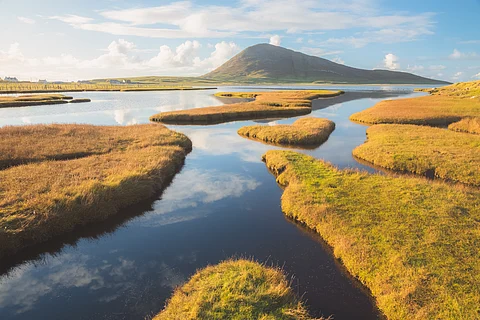
- Destinations
- Experiences
- Stay
- What's new
- Celebrating People
- Responsible Tourism
- CampaignsCampaigns
- Subscribe
- Buy Now

Off the northwestern coast of Scotland lies a chain of islands that seem untouched by time—windswept, sea-sprayed, and steeped in ancient lore. The Outer Hebrides, or Na h-Eileanan Siar in Gaelic, are a string of over 70 islands, with only a handful inhabited. From Harris's white sand beaches to Lewis's Neolithic stone circles, these islands are a world apart—perfect for travellers seeking wild beauty, quiet contemplation, and cultural richness.
Most journeys begin on Lewis, the largest and northernmost island, where millennia of history are carved into the land. The Callanish Standing Stones, older than Stonehenge, are one of the most mystical sights in the British Isles. These stones have stood against a brooding sky for 5,000 years, possibly aligned with lunar events, and remain a powerful symbol of ancient spirituality.
The island's main town, Stornoway, offers a gentle blend of traditional life and modern convenience. Visit Lews Castle, wander its woodlands, and enjoy locally caught seafood at cosy harbour cafés. Don’t miss the Museum nan Eilean, which delves into the Gaelic culture and crofting traditions that define island life.
Drive south from Lewis, and you’ll arrive in Harris, which is connected by a narrow isthmus. While it's geologically the same landmass, Harris has a distinct character—wilder, hillier, and often compared to the Scottish Highlands. But what surprises most visitors are its beaches. The wide, curving expanse of Luskentyre Beach, with turquoise waters and creamy white sands, could easily be mistaken for the Caribbean—until the cool Atlantic breeze reminds you where you are.
Harris is also the spiritual home of Harris Tweed, the world-renowned fabric woven by hand in local crofts. Stop by a weaver’s shed to see this living tradition in action, or visit the Harris Tweed Authority to learn about the strict rules that govern its authenticity.
Further south, the islands of North Uist, Benbecula, South Uist, and Eriskay are connected by causeways that make for a scenic road trip through vast peatlands, lochs, and machair (a unique coastal grassland). These islands are rich in birdlife, including eagles, corncrakes, and puffins, making them a haven for birdwatchers.
In South Uist, ancient ruins, crofting communities, and a devoutly Catholic heritage are reflected in its chapels and wayside shrines. Eriskay, small but storied, is famed for the SS Politician shipwreck in 1941, which inspired the classic book and film Whisky Galore.
Your journey can end (or begin) in Barra, where planes land directly on the beach—one of the world’s most unique runways. The island’s castle, Kisimul, rises dramatically from the sea, and its hills offer panoramic views of the Hebridean seascape.
The Outer Hebrides are among the few places where Scottish Gaelic is still widely spoken, and the culture is infused with oral storytelling, traditional music, and island hospitality. Many towns hold ceilidhs (social gatherings with music and dance), and summer brings community festivals that celebrate everything from sailing to seaweed.
Sunday is a day of rest here, especially in the north, with most shops and services closed. It's a tradition rooted in faith but also a reminder to slow down and appreciate these islands' silence and space.
Getting There: Ferries from the Scottish mainland (Ullapool, Oban, Mallaig) connect to various islands. Flights are also from Glasgow, Inverness, and Edinburgh to Stornoway and Barra.
Getting Around: A car is highly recommended for exploring freely. Public transport is limited but available.
Best Time To Visit: Late spring to early autumn (May to October) offers milder weather, blooming wildflowers, and longer daylight hours.
